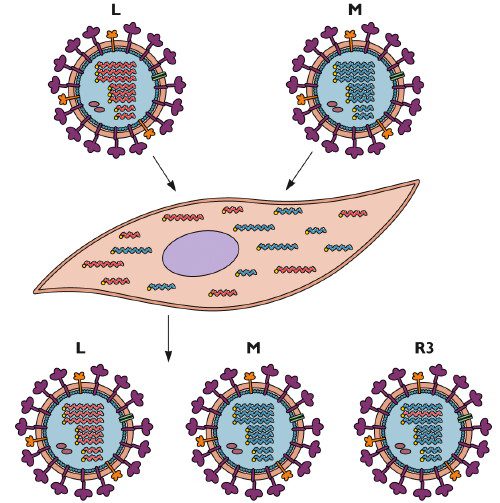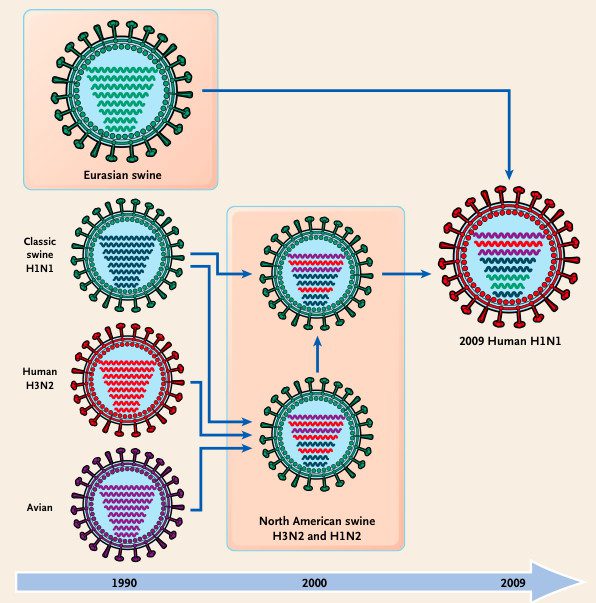Mutation is an important source of RNA virus diversity that is made possible by the error-prone nature of RNA synthesis. Viruses with segmented genomes, such as influenza virus, have another mechanism for generating diversity: reassortment.
When an influenza virus infects a cell, the individual RNA segments enter the nucleus. There they are copied many times to form RNA genomes for new infectious virions. The new RNA segments are exported to the cytoplasm, and then are incorporated into new virus particles which bud from the cell.
If a cell is infected with two different influenza viruses, the RNAs of both viruses are copied in the nucleus. When new virus particles are assembled at the plasma membrane, each of the 8 RNA segments may originate from either infecting virus. The progeny that inherit RNAs from both parents are called reassortants. This process is illustrated in the diagram below, which shows a cell that is co-infected with two influenza viruses L and M. The infected cell produces both parental viruses as well as a reassortant R3 which inherits one RNA segment from strain L and the remainder from strain M.


One example of the evolutionary importance of reassortment is the exchange of RNA segments between mammalian and avian influenza viruses that give rise to pandemic influenza. For example, the 2009 H1N1 pandemic strain is a reassortant of avian, human, and swine influenza viruses, as illustrated.


Reassortment can only occur between influenza viruses of the same type. Why influenza A viruses never exchange RNA segments with influenza B or C viruses is not understood. However, the reason is probably linked to the packaging mechanism that ensures that each influenza virion contains at least one copy of each RNA segment.
Trifonov, V., Khiabanian, H., & Rabadan, R. (2009). Geographic Dependence, Surveillance, and Origins of the 2009 Influenza A (H1N1) Virus New England Journal of Medicine DOI: 10.1056/NEJMp0904572

“Reassortment can only occur between influenza viruses of the same subtype”
I think reassortment can occur between influenza viruses of same type but different subtypes
e.g. between Influenza type A subtype H1N1 and Influenza type A subtype H2N2
And in other news…Denmark is reporting the first case of resistance to Tamiflu: http://news.yahoo.com/s/nm/20090629/ts_nm/us_de…
Vincent, do you have a piece on antiviral resistance? I need to learn more on this topic. I noticed that CDC reports on isolates that are resistant to the various antiviral drugs but shouldn’t there be a continuum considered – not just a binomial classification (yes/no)? For example – how ‘resistant’ is the viral to the drug considered?
You are right, thank you for the correction. The post has been updated.
Pingback: Everything you wanted to know about reassortment but were afraid to ask | Swine Flu Daily Update
world Wave graph on : http://bartelsontour.webs.com
A/H1N1 is a Biological Binary Weapon, we are under BW attack, standard medical procedures
are not the right aproach to this virus, you have to learn the military way of doing it.
Download USAMRIID Blue Book 6th edition
My question is two fold:
1. What is the known rate of evolution that has led to the current outbreak ? This question should be seen in the context of avian flu (birds were culled in India during that outbreak)?
2. In the context of Darwinian principles, can this type of repeated pandemics lead to the extinction of the human species ? (“are the microbes the real rulers of this world”). This question should seen in the context of the fitness of the host being important for the viral multiplication. (What percentage of the microbes are parasites and if the parasites lose out due to selective pressures, in the future, would it affect the ecological balance ?)
3. What about the prophylactic measures from the environmental point of view ?
Thanks,
P.K.Suresh
My question is two fold:
1. What is the known rate of evolution that has led to the current outbreak ? This question should be seen in the context of avian flu (birds were culled in India during that outbreak)?
2. In the context of Darwinian principles, can this type of repeated pandemics lead to the extinction of the human species ? (“are the microbes the real rulers of this world”). This question should seen in the context of the fitness of the host being important for the viral multiplication. (What percentage of the microbes are parasites and if the parasites lose out due to selective pressures, in the future, would it affect the ecological balance ?)
3. What about the prophylactic measures from the environmental point of view ?
Thanks,
P.K.Suresh
Pingback: Twitter Trackbacks for Reassortment of the influenza virus genome [virology.ws] on Topsy.com
Pingback: Pandemic H1N1 influenza virus outcompetes seasonal strains in ferrets
Pingback: What if influenza virus did not reassort?
The reason the CDC can use a binomial classification is because the current antiviral drugs act in a specific manner such that there are specific base pair positions that can be looked at and if there is a mutation that causes an amino acid substitution at that postition, the antiviral will either work or it won't. So you can't get any answer other than yes or no.
I’m happy I found this weblog, I couldnt find out any info on this topic
matter prior to. I also run a site and if you want to ever serious in a
little bit of guest writing for me if feasible feel free to let me
know, i’m always appear for people to examine out my site. Please stop
by and leave a comment sometime!
online gambling sites
Pingback: First human infections with avian influenza H7N9 virus
Pingback: Influenza H5N1 x H1N1 reassortants: ignore the headlines, it’s good science
Pingback: H7N9 is Rapidly Mutating: Pandemic Potential Increased Due To 'Viral Fitness' | The Daily Sheeple
Pingback: | INTELLIHUB
Pingback: H7N9 is Rapidly Mutating: Pandemic Potential Increased Due to ‘Viral Fitness’ | GlobalResearchReport.com
Pingback: H7N9 é mutação rápida: potencial pandêmico aumentado devido ao ‘fitness Viral’ | A Verdade Sobre
Pingback: H7N9 Is Rapidly Mutating: Pandemic Potential Increased Due To ‘Viral Fitness’ | Alternative News Alert!
RNA is not copied in the nucleus.
Pingback: Virology question of the week: why a segmented viral genome?
Yes it is. Influenza requires some differential splicing of its segmented RNA that requires the nuclear enzymes.
Pingback: Opinion: Will Ebola become Airborne like Influenza? | Twiland
Pingback: This crazy new virus just broke the rules of infection | E-Scientific News
Pingback: A Newly Discovered “Bizarre†Virus is Breaking the Rules of Infection – Technology and Longevity Feed
Pingback: Bird flu outbreaks in Gujarat and Maharashtra - Health Issues India